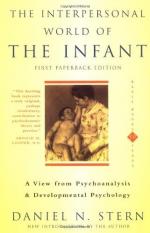|
This section contains 513 words (approx. 2 pages at 400 words per page) |

|
The Interpersonal World of the Infant: A View from Psychoanalysis and Developmental Psychology Summary & Study Guide Description
The Interpersonal World of the Infant: A View from Psychoanalysis and Developmental Psychology Summary & Study Guide includes comprehensive information and analysis to help you understand the book. This study guide contains the following sections:
This detailed literature summary also contains Topics for Discussion and a Free Quiz on The Interpersonal World of the Infant: A View from Psychoanalysis and Developmental Psychology by Daniel N. Stern.
Daniel Stern's The Interpersonal World of the Infant is a theory of the subjective life of young infants. Stern asks whether infants have a sense of self, how they unify experience, perceive objects, share experiences with others, and so on. The point of the inquiry is not only to teach the reader something about human nature but to use his theory of Self Psychology to unify differing scientific perspectives and to make recommendations about clinical practices.
Early on Stern distinguishes between "the observed infant" and "the clinical infant." The observed infant is the theoretical conception of the infant created by scientists who study infant behavior in an experimental setting. In contrast, the clinical infant is the theoretical conception of the infant created by clinicians who provide therapy to adults based on complex psychological models of children. The models of infant psychology provided by the clinical infant model are typically more macro-level and general, but also less scientific than those provided by the observed infant model. Stern believes that both perspectives provide important insights into the subjective life of the infant that can be integrated. His book is an attempt at such integration.
A major aim of the integration is to produce a method of evaluating clinical practice. When clinicians operate independently of experimental data, their developmental models may misidentify, overlook or overemphasize important elements in a patient's life that are crucial to his/her mental health. Much of therapy involves the construction of a life narrative which is used to work towards greater psychological function and bad developmental theory can hamper this process.
Stern calls his view Self Psychology because he holds that senses of the self are the key organizing principle of the subjective experience of the infant. Unlike many of his predecessors, Stern believes that children have rudimentary senses of the self practically from birth and that the original senses of self never disappear. Instead, more developed senses of the self build upon previous senses and rely on them for proper function.
The first two chapters of the book review the themes of the book generally and sets up the contrast between the clinical and the observed infants. Chapters 3 through 8 are the meat of the book and outline Stern's four senses of the self. Chapter 3 reviews the original sense of self, or the emergent sense of self. Chapters 4 and 5 explain the sense of a core self and how it is defined against the infant's sense of others and with the infant's sense of others respectively. Chapter 6 introduces the sense of a subjective self and Chapter 7 explains this sense in terms of Stern's conception of affect attunement. Chapter 8 then builds the final sense of the self, the verbal sense, on top of the previous three.
The final three chapters discuss the clinical implications of Stern's Self Psychology. Chapter 9 explains how the "observed infant" should be utilized by clinicians, Chapter 10 covers the implications that the "observed infant" has for the theories implicit in therapy and Chapter 11 shows how Self Psychology aids in reconstructing a development past for therapy patients.
Read more from the Study Guide
|
This section contains 513 words (approx. 2 pages at 400 words per page) |

|



